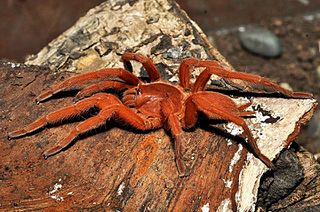
The Goliath birdeater belongs to the tarantula family Theraphosidae. Found in northern South America, it is the largest spider in the world by mass and size, but it is second to the giant huntsman spider by leg span. It is also called the Goliath bird-eating spider; the practice of calling theraphosids "bird-eating" derives from an early 18th-century copper engraving by Maria Sibylla Merian that shows one eating a hummingbird. Despite the spider's name, it only rarely preys on birds.

Brachypelma is a genus of spiders in the family Theraphosidae (tarantulas). They may have bodies up to 6 cm long with legs of similar or greater lengths. Some species have brightly colored legs, with red or orange marks and rings.

Ornithoctoninae is a subfamily of tarantulas found in Southeast Asia. It was first erected in 1895 by Reginald Innes Pocock based on the type specimen Ornithoctonus andersoni. Terrestrial members of this subfamily are often known as earth tigers.

Annandaliella travancorica is a species of tarantula spider found in the Western Ghats of India. It was the first of three members of the genus Annandaliella to be described, therefore the type species.

Ceratogyrus is a genus of tarantulas found in southern Africa. They are commonly called horned baboons for the foveal horn found on the peltidium in some species. They are readily distinguished from other African theraphosid genera by the combined presence of a retrolateral cheliceral scopula, composed of plumose, stridulatory setae, and the strongly procurved fovea. The fovea is typically strongly procurved and in some species surrounds a distinct protuberance. this protuberance may take the form of a simple posterior extension of the caput, a low-set plug or a prominent, discrete conical projection. All Ceratogyrus species possess a pale yellow anteriorly placed, transverse, sub-abdominal band. This feature is not distinct in other Harpatirinae except Augacephalus junodi. The absence of dense, ventral femoral fringes on the palpi and legs I and II distinguish Ceratogyrus spp. from female A. junodi.

Tarantulas comprise a group of large and often ″hairy″ spiders of the family Theraphosidae. Currently, about 1,000 species have been identified. The term tarantula is usually used to describe members of the family Theraphosidae, although many other members of the same infraorder (Mygalomorphae) are commonly referred to as "tarantulas" or "false tarantulas". Some of the more common species have become popular in the exotic pet trade. Many New World species kept as pets have urticating hairs that can cause irritation to the skin, and in extreme cases, cause damage to the eyes.
Pelinobius is a monotypic genus of east African tarantulas containing the single species, Pelinobius muticus. It was first described by Ferdinand Anton Franz Karsch in 1885, and is found in Tanzania and Kenya.
Neischnocolus is a genus of spiders in the family Theraphosidae. It was first described in 1925 by Petrunkevitch. The genus Ami was separately described in 2008, but was later discovered to be a junior synonym of Neischnocolus. Species are native to Central America and northern South America.

Theraphosa apophysis is a species of spider in the family Theraphosidae, found in Venezuela and Brazil.

Cyriopagopus is a genus of southeast Asian tarantulas found from Myanmar to the Philippines. As of March 2017, the genus includes species formerly placed in Haplopelma. It was first described by Eugène Louis Simon in 1887.
Neoheterophrictus bhori is a species of tarantula. It is native to Parambiculam, Western Ghats, Cochin province, India.
Bacillochilus is a monotypic genus of African tarantulas containing the single species, Bacillochilus xenostridulans. The genus and sole species were both described by R. C. Gallon in 2010, and is found in Angola. The name is a combination of the Ancient Greek "xénos" (ξενος), meaning "foreign" or "strange", and the Latin "stridulere", meaning "to creak". It is a reference to the unusual form of the stridulatory organ that distinguishes it from other members of the subfamily Harpactirinae.
The Eumenophorinae are a subfamily of tarantula spiders. They are known from 13 genera distributed across Africa, southwestern countries in Saudi Arabia, and Madagascar and the associated islands.
Selenogyrus is a genus of spider, or more specifically, selenogyrine theraphosid. The type species is Selenogyrus caeruleus.

Sericopelma is a genus of tarantula, found in Central America from Nicaragua to Panama. The limits of the genus and its distribution have long been confused; it is closely related to the genus Aphonopelma. Sericopelma species are among the largest found in Central America. They can be kept as pets, although at least one species has been described as "very aggressive".

Orphnaecus philippinus, known as the Philippine tangerine, is a species of tarantula. It is native to the Philippines.

Avicularia purpurea, also called purple tree tarantula, Ecuadorian purple tarantula or Ecuador purple pinktoe, is a species of spider belonging to the family Theraphosidae (tarantulas).
Augacephalus is a genus of harpacterine theraphosid spiders. It has three species, all of which are found in Africa.
Tliltocatl aureoceps is a possible species of spider in the family Theraphosidae (tarantulas). The World Spider Catalog regards it as a nomen dubium. Only one female has been described; this was captured in the Florida Keys, but is likely to have been imported from Mexico.

Tliltocatl epicureanus is a species of spider in the family Theraphosidae (tarantulas), found in the Yucatán Peninsula of Mexico.











